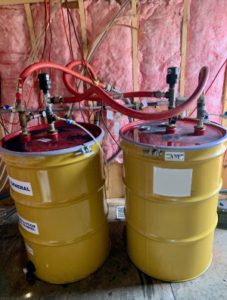Five Things You Should Think about When Remediating PFAS
Remediation is one of the most important steps towards the goal of reducing the amount of exposure to per- and polyfluoroalkyl substances (PFAS).
Although the full scope of PFAS including exposure, toxicities, and human health effects are still being researched, there is overwhelming evidence that remediation should proceed without delay, particularly in the case of contaminated water.
As environmental professionals we want to keep up with the latest water remediation technologies, but what if the existing methods we have already perfected could actually be the best option for cleaning up PFAS? It turns out that the best water remediation technology found in the United States is to “pump and treat” PFAS contaminated water through granulated activated carbon (GAC) filtering technology. Hydro-Terra Group (HTG) and our staff have perfected the use of GAC filtering technology and “pump and treat” remediation of petroleum hydrocarbons and chlorinated solvent contaminated water for over 30 years and is prepared to remediate PFAS too.
Hydro-Terra Group’s professionals are pleased to provide you with this simplified list of five things you should think about when remediating PFAS:
- PFAS are a group of more than 6,000 chemicals that do not occur naturally in the environment; all PFAS are man-made. They were first manufactured in the U.S. in the 1940’s. The most regulated PFAS are perfluorooctane sulfonic acid (PFOS) and perfluorooctanoic acid (PFOA). PFOS and PFOA belong to a group of PFAS known as perfluoroalkyl acids (PFAAs). PFAAs is a collective term to describe a group of about 25 PFAS that are extremely stable in the environment, do not break down under ambient conditions, and are considered terminal PFAS. PFOA and PFOS have been sought after for their oil-resistant, grease-resistant and water-resistant applications. PFOS and PFOA were phased out of production in the U.S. in 2002 and 2015; however, similar alternatives such as “GenX” are still being manufactured. Remediation through GAC filtering does not eliminate the source, but it can greatly reduce the PFAS, including the newer alternatives from making their way into the population.
- PFAS are the focus of active research and study because new information on their toxicity and health effects are emerging every day. PFAS have been linked to immune suppression, decreased vaccination response, high cholesterol, elevated liver enzymes, low birth weight, and kidney cancer among other health risks. The U.S. Environmental Protection Agency (EPA) is currently working with other government agencies to research and establish toxicity values based on scientific understanding. Although the EPA has not established a Maximum Contaminant Level (MCL) for drinking water, some states, including Pennsylvania, have established their own MCLs. Remediation through GAC filtering can greatly reduce the amount of PFAS in drinking water so that each state’s unique regulatory requirements can be met.
- PFAS bioaccumulate in humans, animals and plants. PFAS have the ability to disperse over long distances through air and water because they are chemically and thermally stable, water soluble, extremely mobile in groundwater, and not volatile. PFAS have been detected in waterways and drinking water systems nationwide. They are transported through rainwater run-off and enter surface water bodies or seep through the soil and migrate into groundwater aquifers. PFAS are mostly anions when the pH is greater than 3 and have the ability to disperse over long distances. PFAS can be detected far from any areas of manufacturing or use, including the arctic. The longer someone/ something is exposed the more PFAS bioaccumulate because more are being absorbed than being eliminated. Although the half-life of all 6,000+ PFAS are unknown, the half-life in humans is estimated at 3.5 years for PFOA and 4.8 years for PFOS. A reduction in spread and length of exposure to PFAS is remedial goal that GAC filtering technologies can provide.
- PFAS bio transform, they don’t biodegrade. PFAS generally consist of a head and a tail. The tail includes a chain of strong carbon fluorine (C-F) bond that can be short (less than 8 carbons) or long, branched or linear isomers. The head consists of at least one functional group such as carboxylic acid. The heads are interchangeable, hydrophilic (attracted to water), and considered social. The tails are hydrophobic (repel water) and considered anti-social. The C-F bond is nearly impossible to break except under extremely high temperatures and mineralization only occurs at temperatures over 1,100 degrees C. When the weaker bond between the head and tail breaks apart, they are able to bio transform. The polyfluorinated compounds are consider precursors to the perfluourinated compounds because they can bio transform over time into a one of various PFAAs. GAC filtering technologies trap PFAS, including PFAAs and those prone to transform into PFAAs.
- Although there are multiple exposure routes, exposure primarily occurs through ingestion of contaminated water. Studies have shown that the use of GAC filtering technology can greatly reduce the amount of PFAS that get ingested through contaminated drinking water. PFAS are removed through adsorption, which means dissolved PFAS adhere to the surface of the carbon. The adsorption process is capable of 90-99% removal efficiency.
HTG has been using GAC filtering technology to reduce contamination in drinking water, stormwater, and wastewater for over 30 years and can complete your PFAS remediation from start to finish and assist in meeting each state’s unique regulatory PFAS requirements from the investigation phase through the remediation phase. If you are interested in learning more about remediation of PFAS or the need for GAC filtering technology, please contact Hydro-Terra Group at (410) 861-5376 or (717) 980-5150.


